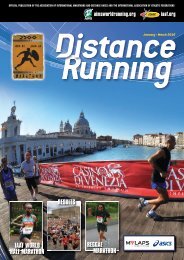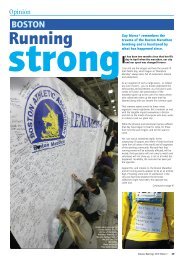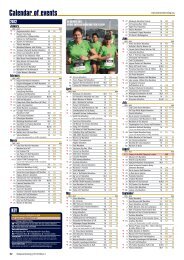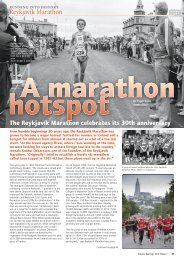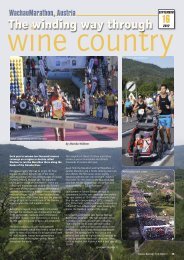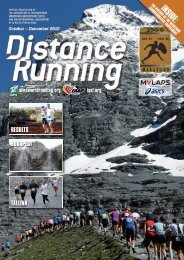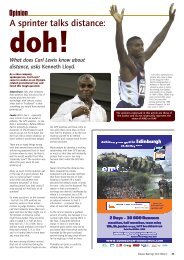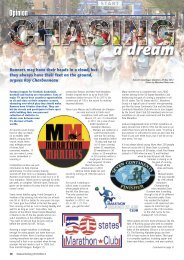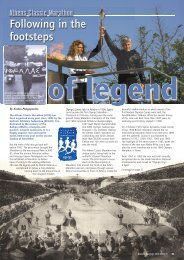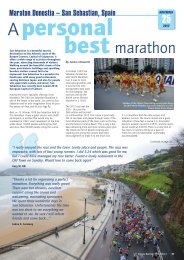Download pdf - Distance Running magazine
Download pdf - Distance Running magazine
Download pdf - Distance Running magazine
Create successful ePaper yourself
Turn your PDF publications into a flip-book with our unique Google optimized e-Paper software.
Reliability<br />
One of the most important aspects of a timing<br />
system is its reliability. After intensive training,<br />
running the race and finally reaching the finish<br />
line, participants want to have their times right.<br />
This increases the pressure on an event and on the<br />
timing system used during the event. Social media<br />
can easily create a negative reach when timing<br />
fails. The most commonly and longest used<br />
MYLAPS ChampionChip timing system is still the<br />
most reliable system for mass events. Over 99,8%<br />
of the participants are read correctly by the timing<br />
system.<br />
With new technologies, such as UHF technology, it<br />
has become easier to make a timing system that<br />
works but to make a reliable timing system that<br />
works in mass events is a real challenge. In timing<br />
systems that employ commonly used UHF<br />
technology water is the biggest issue to deal with.<br />
As a body contains of 75% of fluid, mass packed<br />
participants at starts easily get missed. This is why<br />
the MYLAPS BibTag system uses spacers to keep<br />
the timing tag separated from the body of the<br />
athlete. In this way the MYLAPS BibTag system<br />
assures over 99,7% reliability in mass events.<br />
Accuracy<br />
Besides reliability, accuracy is another relevant<br />
requirement. Many athletes will train for weeks,<br />
months or even years to improve their<br />
performance. Providing accurate results to<br />
organizers, competitors and spectators is essential<br />
for the success of an event. For elite runners<br />
accuracy should be within 0,5 of a second to<br />
certify times of the athletes. There are systems<br />
available in the market with different accuracy,<br />
ranging from 0,001 of a second (MYLAPS ProChip<br />
system) and systems out there with more than two<br />
seconds.<br />
Detection<br />
Besides scoring differently on the detection rate,<br />
you can distinguish between detection on the foot<br />
and on the chest. The MYLAPS ChampionChip<br />
system is developed for detection on the foot. The<br />
energy fields of the detection mats are optimized<br />
for a specific height of detection and can therefore<br />
not be used for timing on the chest. The MYLAPS<br />
BibTag system is designed for timing on the chest<br />
and integrates the timing tag into the start<br />
number (according to the IAAF standard). The<br />
benefits of the BibTag system are clear: minimal<br />
pre-race handling, no post-race handling and ease<br />
of use for participants. The uniqueness of the<br />
MYLAPS BibTag system is the combination of a<br />
friendly handling process with the quality,<br />
reliability and years of experience of the existing<br />
ChampionChip system.<br />
International regulations<br />
When choosing a UHF timing<br />
system, you should be aware<br />
of international regulations.<br />
Different UHF frequencies are<br />
available per geographical<br />
region, per governing body.<br />
Changing frequencies implies<br />
different design of detection mats.<br />
MYLAPS offers geographically differentiated<br />
BibTag systems that comply with these<br />
governing rulings.<br />
Environment<br />
With ISO 20121 in mind, organizers strive to<br />
reduce environmental impact of their events. The<br />
right timing system can contribute to green event<br />
management. Most MYLAPS timing systems support<br />
re-usable chips. The MYLAPS ChampionChip system<br />
even offers a personal solution that minimizes<br />
waste. A personal (yellow) ChampionChip is owned<br />
by the runner and handling is eliminated as the<br />
participants register and bring their own chip. The<br />
more runners that use a personal chip, the lower<br />
the impact on the environment.<br />
The Road Race Management Guide to Greener<br />
<strong>Running</strong> Events advises: “…chip ownership is the<br />
most environmentally responsible and resource<br />
efficient option out there…”<br />
Those aspects described in this article can help<br />
when selecting the best timing system for your<br />
events. Should you have any questions or if you<br />
need advice, do not hesitate to contact us via<br />
info@mylaps.com or contact the local office<br />
(contact details on mylaps.com)<br />
“…chip ownership<br />
is the most<br />
environmentally<br />
responsible and<br />
resource efficient<br />
option out there…”<br />
<strong>Distance</strong> <strong>Running</strong> | 2011 Edition 4 59



